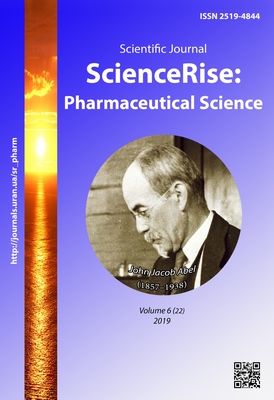Primary screening of the biological activity of heterocyclic aminoderivatives of 2,3-dichloro-1,4-naphtoquinone
DOI:
https://doi.org/10.15587/2519-4852.2019.188127Keywords:
aminopyrazole 2, 3-dichloro-1, 4-naphthoquinone derivatives, primary biological screening, GUSAR programAbstract
The aim. Check the antimicrobial and fungicidal activity of 2,3-dichloro-1,4-naphthoquinone aminopyrazole derivatives and predict their severity of toxicity to rats.
Materials and methods of the research. The antimicrobial activity of heterocyclic amino derivatives of naphthoquinone 3a-d was studied by diffusion of the substance into agar on solid nutrient medium and by serial dilution. Acute rodent toxicity was determined by the QSAR simulation method implemented in GUSAR software.
Results. In the work, the antimicrobial and fungicidal activities of new heterocyclic amino derivatives of naphthoquinone were studied, as well as the in silico determination of their acute toxicity for rats was carried out using four types of substance administration.
Conclusions. The study of aminopyrazole derivatives of naphthoquinone revealed the compounds exhibiting high antimicrobial activity against the Candida tenuis test culture, namely: 2-chloro-3-((1-methyl-1H-pyrazol-4-yl) amino) naphthalene-1,4-dione (3a) and 2-chloro-3 - ((1-methyl-1H-pyrazol-3-yl) amino) naphthalene-1,4-dione (3b). All the synthesized compounds were found to exhibit selective bacterio- and fungistatic activity. QSAR determined the non-toxic compound 3c in the intraperitoneal route of administration, as well as the non-toxic compound 3d in the subcutaneous route of administration
Supporting Agency
- Національний університет "Львівська політехніка"
References
- Janeczko, M., Demchuk, O. M., Strzelecka, D., Kubiński, K., Masłyk, M. (2016). New family of antimicrobial agents derived from 1,4-naphthoquinone. European Journal of Medicinal Chemistry, 124, 1019–1025. doi: http://doi.org/10.1016/j.ejmech.2016.10.034
- Shakh, Y. U., Romanenko, I., Slesarchuk, M., Syngaevsky, V., Kovalchuk, O., Bolibrukh, K. et. al. (2017). Synthesis and Antimicrobial Activity of 1,4-Naphthoquinones Derivatives with [1,2,4]-Triazole-3-thione Substitution. Indian Journal of Pharmaceutical Sciences, 79 (4), 650–654. doi: http://doi.org/10.4172/pharmaceutical-sciences.1000275
- Wellington, K. W., Kolesnikova, N. I., Nyoka, N. B. P., McGaw, L. J. (2018). Investigation of the antimicrobial and anticancer activity of aminonaphthoquinones. Drug Development Research, 80 (1), 138–146. doi: http://doi.org/10.1002/ddr.21477
- Wellington, K. W. (2015). Understanding cancer and the anticancer activities of naphthoquinones – a review. RSC Advances, 5 (26), 20309–20338. doi: http://doi.org/10.1039/c4ra13547d
- Ravichandiran, P., Subramaniyan, S. A., Kim, S. Y., Kim, J. S., Park, B. H., Shim, K. S., Yoo, D. J. (2019). Synthesis and Anticancer Evaluation of 1, 4‐Naphthoquinone Derivatives Containing a Phenylaminosulfanyl Moiety. ChemMedChem, 14 (5), 532–544. doi: http://doi.org/10.1002/cmdc.201800749
- Xu, K., Xiao, Z., Tang, Y. B., Huang, L., Chen, C.-H., Ohkoshi, E., Lee, K.-H. (2012). Design and synthesis of naphthoquinone derivatives as antiproliferative agents and 20S proteasome inhibitors. Bioorganic & Medicinal Chemistry Letters, 22 (8), 2772–2774. doi: http://doi.org/10.1016/j.bmcl.2012.02.086
- López López, L. I., Flores, N., Daniel, S., Silva Belmares, S. Y., Sáenz Galindo, A. (2014). Naphthoquinones: biological properties and synthesis of lawsone and derivatives-a structured review. Vitae, 21 (3), 248–258.
- El-Najjar, N., Gali-Muhtasib, H., Ketola, R. A., Vuorela, P., Urtti, A., Vuorela, H. (2011). The chemical and biological activities of quinones: overview and implications in analytical detection. Phytochemistry Reviews, 10 (3), 353–370. doi: http://doi.org/10.1007/s11101-011-9209-1
- Liu, F. (2012). Synthesis of natural products and small molecules using quinones. doi: http://doi.org/10.31274/etd-180810-2332
- Ibis, C., Sahinler Ayla, S., Yavuz, S. (2019). Reactions of quinones with some aryl phenols and synthesis of new quinone derivatives. Synthetic Communications, 49 (2), 202–211. doi: http://doi.org/10.1080/00397911.2018.1546403
- Ravichandiran, P., Kannan, R., Ramasubbu, A., Muthusubramanian, S., Samuel, V. K. (2016). Green synthesis of 1,4-quinone derivatives and evaluation of their fluorescent and electrochemical properties. Journal of Saudi Chemical Society, 20, S93–S99. doi: http://doi.org/10.1016/j.jscs.2012.09.011
- De Moraes, T., Filha, M., Camara, C., Silva, T., Soares, B., Bomfim, I. et. al. (2014). Synthesis and Cytotoxic Evaluation of a Series of 2-Amino-Naphthoquinones against Human Cancer Cells. Molecules, 19 (9), 13188–13199. doi: http://doi.org/10.3390/molecules190913188
- Sieveking, I., Thomas, P., Estévez, J. C., Quiñones, N., Cuéllar, M. A., Villena, J. et. al. (2014). 2-Phenylaminonaphthoquinones and related compounds: Synthesis, trypanocidal and cytotoxic activities. Bioorganic & Medicinal Chemistry, 22 (17), 4609–4620. doi: http://doi.org/10.1016/j.bmc.2014.07.030
- Ansari, A., Ali, A., Asif, M., Shamsuzzaman, S. (2017). Review: biologically active pyrazole derivatives. New Journal of Chemistry, 41 (1), 16–41. doi: http://doi.org/10.1039/c6nj03181a
- Jahangir, A. Md. et. al. (2015). A review on pyrazole chemical entity and biological activity. International Journal of Pharmaceutical Sciences and Research, 6, 1433–1442.
- El Shehry, M. F., Ghorab, M. M., Abbas, S. Y., Fayed, E. A., Shedid, S. A., Ammar, Y. A. (2018). Quinoline derivatives bearing pyrazole moiety: Synthesis and biological evaluation as possible antibacterial and antifungal agents. European Journal of Medicinal Chemistry, 143, 1463–1473. doi: http://doi.org/10.1016/j.ejmech.2017.10.046
- Rizk, H. F., Ibrahim, S. A., El-Borai, M. A. (2015). Synthesis, fastness properties, color assessment and antimicrobial activity of some azo reactive dyes having pyrazole moiety. Dyes and Pigments, 112, 86–92. doi: http://doi.org/10.1016/j.dyepig.2014.06.026
- Coyle, M. B. (2005). Manual of Antimicrobial Susceptibility Testing. American Society for Microbiology. Washington: American Society for Microbiology, 236.
- McFarland, J. (1907). Nephelometer: An Instrument for Estimating the Number of Bacteria in Suspensions Used for Calculating the Opsonic Index and for Vaccines. Journal of the American Medical Association, 49 (14), 1176–1178. doi: http://doi.org/10.1001/jama.1907.25320140022001f
- Polish, N. V., Marintsova, N. G., Zhurakhivska, L. R., Novikov, V. P., Vovk, M. V. (2019). Synthesis and prediction of the biological activity of heterocyclic n-derivatives naphthoquinone. Chemistry, Technology and Application of Substances, 2 (1), 69–75. doi: http://doi.org/10.23939/ctas2019.01.069
- Lagunin, A., Zakharov, A., Filimonov, D., Poroikov, V. (2011). QSAR Modelling of Rat Acute Toxicity on the Basis of PASS Prediction. Molecular Informatics, 30 (2-3), 241–250. doi: http://doi.org/10.1002/minf.201000151
Downloads
Published
How to Cite
Issue
Section
License
Copyright (c) 2019 Nataliia Polish, Olha Voytsakhivska, Nataliia Marintsova, Lesya Zhurakhivska, Volodymyr Novikov, Serhii Bohza

This work is licensed under a Creative Commons Attribution 4.0 International License.
Our journal abides by the Creative Commons CC BY copyright rights and permissions for open access journals.








